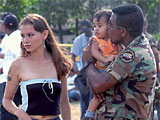Time Stands Still in Tierralta
By Enzo Nussio for ISN
Fighting between two armed groups forced hundreds to flee their homes in a rural area of the extensive Colombian municipality of Tierralta, located in the northwestern Córdoba department, in October.
The two groups, the Black Eagles and the Paisas, emerged after the demobilization of the paramilitary United Self-Defense Group of Colombia (AUC), a national federation of various regional counterinsurgent groups, between 2003 and 2006. These new groups are now filling the vacuum the AUC left behind.
Exactly 100 years after its founding, Tierralta’s history seems to repeat itself. When natives such as Enrique, a local NGO representative whose name has been changed for security reasons, talk about the past, they divide it in eras of dominance of armed groups.
“First, there were the liberal guerrillas in the 1950s followed by the Popular Liberation Army (EPL). In the 1980s, the paramilitaries fought them back. Later, the Revolutionary Armed Forces of Colombia (FARC) entered the scene, which reactivated the paramilitaries,” he tells ISN Security Watch.
A state of neglect
The Uribe government negotiated a peace treaty in Tierralta with the AUC, then a powerful paramilitary federation, in 2003. But this attempt at peace, a cornerstone of the government’s ‘democratic security’ policy, had no sustainable impact for Tierralta.
Quite the contrary, in Córdoba, the number of homicides doubled between 2004 – before the demobilization of the Córdoba-based factions of the AUC – and 2008. Tierralta has seen a steady rise of homicide and forced displacement rates since 2004. A recent report from the Colombian public defender's office (Defensoría) qualifies Tierralta as a high-risk municipality. “This region has been forgotten by the government,” says Enrique.
The Black Eagles of the now-imprisoned former AUC member Daniel Rendón Herrera, also known as ‘Don Mario,’ dominate Tierralta. The Paisas are the military arm of a Medellín-based criminal organization formerly led by AUC commander Diego Fernando Murillo, or ‘Don Berna.’ The two groups are locked in a battle for influence over Tierralta.
Local sources claim that the authorities somehow tolerate the activities of the new armed groups and concentrate their efforts on FARC, which is still present in remote areas of Tierralta. Two high-ranking military officials have even been arrested for collaborating with the new groups.
A coca cornucopia
The rural municipality nearly the size of Belgium is a strategically important location for coca cultivation and trafficking. Behind it, large mountain chains form the Nudo del Paramillo, a natural hideout for armed actors with important connection routes to other regions. According to a police report, nearly six square kilometers of land are used for coca cultivation in Tierralta.
This geostrategic importance lured the armed groups. The peace process support mission of the Organisation of American States (MAPP-OEA) claims that particularly former mid-level AUC members were involved in the constitution of these new groups in different parts of the country. The debate about their principal interests is highly controversial.
The government calls them “emerging criminal gangs,” arguing they are interested merely in drug trafficking, and point to the conflict over territorial control. Occasionally, the groups collaborate with the guerrillas in trafficking. According to Defensoria, FARC controls a portion of the coca cultivation in the department, while the Black Eagles oversee the transport routes.
Critical voices do not agree with the reduced focus on the criminal dimension of these groups and believe they are a continuation of the AUC, using the same methods of social control and coercion and are often the same people. NGO official Enrique says that the locals call them just “paramilitaries.” “There is nothing ‘emerging’ about them.”
The lure of money
According to the author's investigations, the majority of demobilized paramilitaries from Tierralta entered the AUC ranks due to a lack of economic opportunities. “The only formal employer here is the mayor’s office,” says José, one of the approximately 800 demobilized people in the municipality. The most lucrative ‘job’ alternatives are often coca cultivation or engagement in one of the armed groups.
“When I was demobilized and had no job, I first worked as a coca leaf picker,” he tells ISN Security Watch, adding that he has received offers to join the armed groups, as have most of his fellow demobilized fighters.
The Toledo International Centre for Peace (CITpax) states in a soon-to-be-published report that the groups in Tierralta have attracted a small yet significant percentage of the ex-combatant population and other young men into their ranks with a combination of money and coercion. The Black Eagles offer a monthly salary of at least $200 – a decent wage for this region.
With the demobilization of the AUC and the fallback of the guerrilla movement due to intensified government efforts, the Colombian conflict has gone through a deep transformation.
The government even denies the existence of an armed conflict. However, in remote areas such as Tierralta, the root causes of conflict persist and the changed situation has not produced lower levels of violence. It is in these areas where the shortcomings of the government’s military and police-driven security understanding are particularly evident.

